Sony Alpha SLT-A35 Review
Sony Alpha SLT-A35
The Alpha SLT-A35 is the latest Sony camera to use translucent mirror technology, and delivers speedy autofocus and fast continuous shooting.
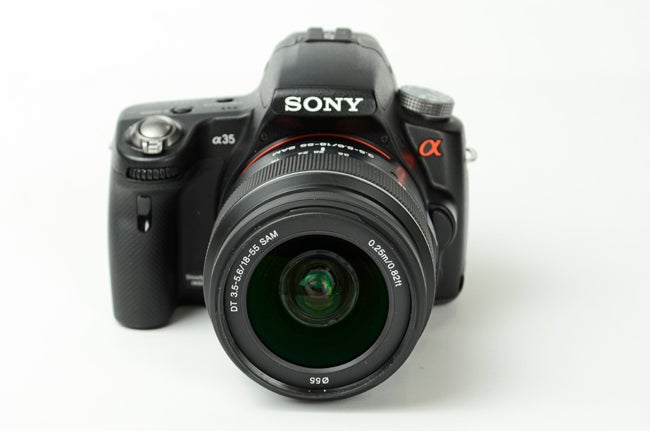
Verdict
Pros
- Super fast AF
- 5fps/7fps continuous shooting
- Very good image quality
Cons
- Electronic Viewfinder has its limitations
- Feels a bit plastic
- Tele-Zoom (7fps) mode is JPEG only
Key Specifications
- Review Price: £599.00
- 16.2-megapixel sensor
- Sony BIONZ image processor
- ISO 100-12,800
- 5fps in standard mode, 7fps in Tele-Zoom
- 1080/50i Full HD movie recording
We’ve seen sensors become more populated with pixels, maximum sensitivities raised, dynamic ranges expanded and many more things besides. And we’ve also seen the birth of new types of cameras altogether, such as the compact system camera. Sony’s Single Lens Translucent (SLT) range, which includes this SLT-A35, falls neatly into this latter bracket. These cameras offer an interesting design that falls somewhere between a traditional DSLR and a compact system camera.
In a nutshell, it’s all down to the internal mirror. Whereas a regular DSLR has a solid mirror that reflects 100% of what it sees, SLT cameras such as the A35 use a translucent mirror design that partly reflects the image and partly allows it to pass directly through. In practical terms this allows SLT cameras to provide a simultaneous live feed to both the phase-detection AF module in the roof of the camera as well as the image sensor at the back of the camera.
The main benefit of this arrangement is that there are no moving parts – the internal mirror remains in position at all times – thereby allowing continuous, lightning-fast phase-detection autofocus to be maintained, even when the camera’s being used in live view mode. In addition, SLT cameras can also achieve a faster continuous shooting speed – up to 7fps on the A35. This makes SLT cameras ideal for sport, wildlife and all kinds of situations where the emphasis is on being able to capture fast-moving action.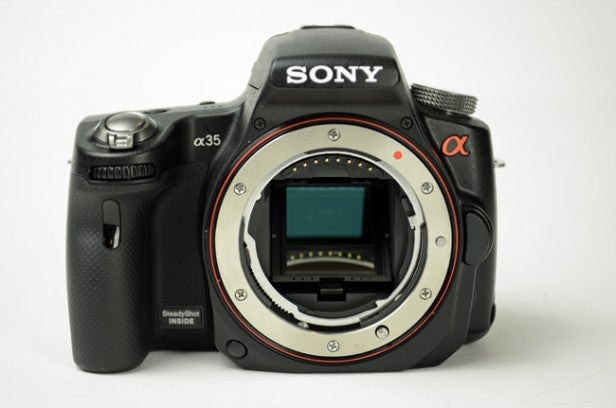
Sadly though, there is a price to be paid for this arrangement, which is the lack of an optical viewfinder and the reliance, instead, on an electronic viewfinder. Does this spoil the party, or are the inherent benefits of SLT technology enough to render this a minor inconvenience?
Let’s take a closer look and find out.
The A35 takes over from the now discontinued A33 as the junior partner in Sony’s SLT range, with the A55 remaining the flagship model for the time being. That said, the two models are actually quite similar, at least in terms of core specifications. The A55 is a shade faster at 10fps, and also benefits from a hinged LCD monitor. No doubt the A55’s successor will put more distance between it and the A35, but for now these are the two main differences.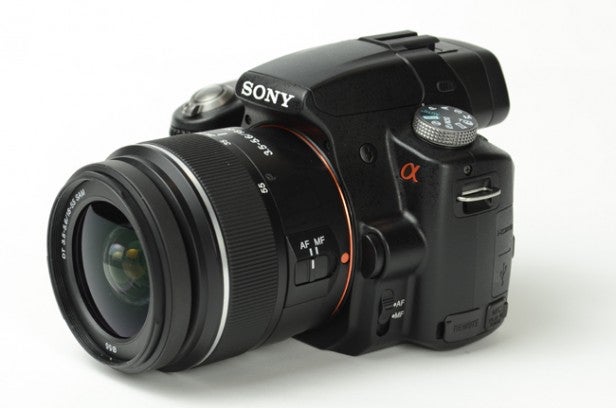
At its heart the A35 improves on the 14.2-megapixels of the A33 with a newly-developed 16.2-megapixel APS-C Exmor HD CMOS sensor that’s wired on the non light-sensitive side for better low-light performance, along with Sony’s latest generation of BIONZ image processor. This enables the A35 to shoot at 5.5fps in regular use, or 7fps when using the new Tele-Zoom function (more on this shortly). Sensitivity, meanwhile, stretches from a very credible ISO 100 to 12,800.
With a default aspect of 3:2 the A35 is capable of outputting a maximum 4912 x 3264 pixels at full resolution (plenty enough for poster-sized prints should you wish to make them), with further options to shoot at 8.4MP or 4MP. You can also choose to shoot in 16:9, although given that in order to do this the camera effectively just takes a crop from the sensor, maximum resolution is pegged back to 14MP, with 7.1MP and 3.4MP options also available. In addition to being able to shoot regular JPEGs in a choice of Fine or Standard quality, the A35 can also record lossless Raw images (in Sony’s .ARW format) for enhanced post-production opportunities.
As an enthusiast-level camera the A35 comes with the regular quartet of creative manual and semi-manual shooting modes: Program, Aperture-priority, Shutter-priority and Manual. However, should you want to let the camera take complete control there are also a couple of point-and-shoot Automatic modes including Sony’s own Auto shooting mode that allows for automatic scene detection, plus a forced Flash Off mode for when the use of flash is restricted.
Other shooting mode options include eight individual Scene modes and 11 Picture Effect modes that, somewhat bizarrely, are grouped together under one sub-menu. We say this because they are actually quite different tools and therefore probably deserving of their own individual notch on the dial. The Scene modes are the regular selection of Portrait, Landscape, Night Portrait and suchlike as found on all digital cameras, while the Picture Effects are essentially a set of digital filters ranging from a Posterization effect, to High Key, Retro and Toy Camera.
In addition to these filter effects, the A35 also offers the regular range of Sony Creative Styles. These are essentially JPEG processing commands that can be used to give your JPEGs a particular look. Preset Creative Styles include: Standard, Vivid, Portrait, Landscape, Sunset and Black & White. It’s possible to tweak the individual contrast, sharpness and saturation levels for each of these presets if you don’t like the default settings.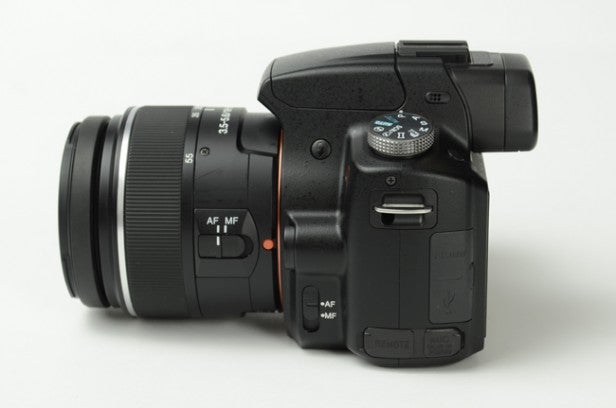
This being a Sony camera, there’s also a Sweep Shooting option that enables you to create extreme wideangle images by panning the camera in a predetermined direction with the shutter button held. While we’ve championed this technology in previous reviews for the great results it can produce, it does prove slightly more fiddly to operate here than on other Sony cameras, with the sweeping motion itself harder to exact. When it works though, the results are still very good.
Last, but not least, is the Tele-Zoom shooting mode. This is a speed-specific option that enables quicker continuous burst shooting by taking a crop from the centre of the screen equivalent to 1.4x the selected focal length. With it engaged the A35 can shoot at 7fps, although it’s worth noting that images can only be captured as JPEGs and at a resolution of 8.4MP. This means it’s not possible to record Tele-Zoom images as lossless Raw files. Whether this will be a problem will of course depend on how much post-production work you want to carry out on your images.
In addition to being a solid stills camera, the A35 offers some solid, if not particularly numerous, movie-recording abilities. Those looking for maximum all-round quality should be more than happy with the top setting of 1080p Full HD at 50i, with files stored in the AVCHD format. Aside from this though the only other choices are 1440 x 1080 at 25fps, and VGA-quality 640 x 480 at 25fps, both of which are stored as MP4 files. Sound is recorded in mono, however there is an external microphone input should you wish to record in stereo.
In the hand the A35 feels very much like a regular DSLR, albeit quite a small one. The camera’s outer construction is almost entirely plastic, with a slightly mottled finish that attempts to imitate the magnesium alloy construction of more expensive cameras. The finger-grip is only really big enough for two fingers, although both it and the thumb grip have been given a texturised rubber finish that makes your grip far more secure.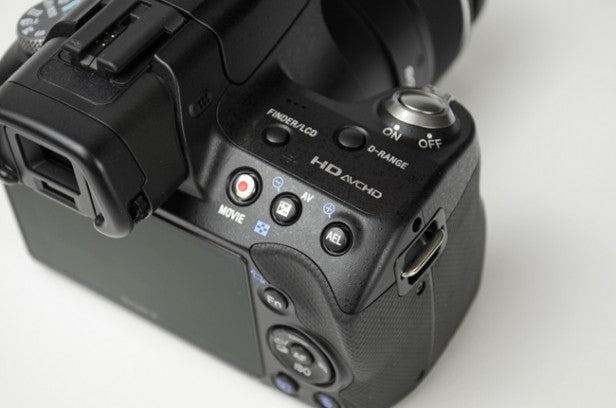
On the back of the A35 sits a 3in TruBlack LCD monitor with a resolution of 921,000 pixels, which is as sharp as 3in monitors currently get. The A35’s screen is an elongated 16:9 widescreen aspect rather than the regular 3:2 display more common to DSLRs. This means that regular 3:2 still images can appear a bit small when viewed on the screen. However, when the A35 is being used to record movies (or when you’re shooting in 16:9 aspect) the image will fill the entire screen.
Sadly, there’s no optical viewfinder either, although Sony has seen fit to attach an electronic viewfinder (EVF) offering 100% coverage. It’s not particularly large but it is bright and at over a million pixels it’s actually pretty sharp too. Indeed, as EVFs go it’s pretty good, further benefiting from an eye sensor that automatically switches between the screen and the EVF with minimal fuss when the A35 is lifted to eye level.
That said, it’s still no substitute for a traditional optical viewfinder and also suffers from the usual stuttering problems when the camera is trained on a fast-moving subject. If you’re seriously considering splashing out on the A35, then it’s essential that you weigh this up before parting with your money because it’s a big trade-off.
Controls are well-spaced and easy to reach, with the one-touch movie record button and standalone D-Range button able to be re-assigned to your own preferences – both nice touches. It’s also good to see an AEL button to hand for those situations where a bit of creative metering is required. In-camera menus are similarly easy to browse, with the Function button acting as a gateway to a kind of Quick Settings menu for regularly accessed shooting controls.
Turning to performance, the 15-point phase-detection AF module of the A35 delivers exceptionally fast focusing in all light conditions, including dim lighting. The camera’s AF points are laid out in a diamond shape across the central portion of the screen with three cross-type sensors running through the middle. 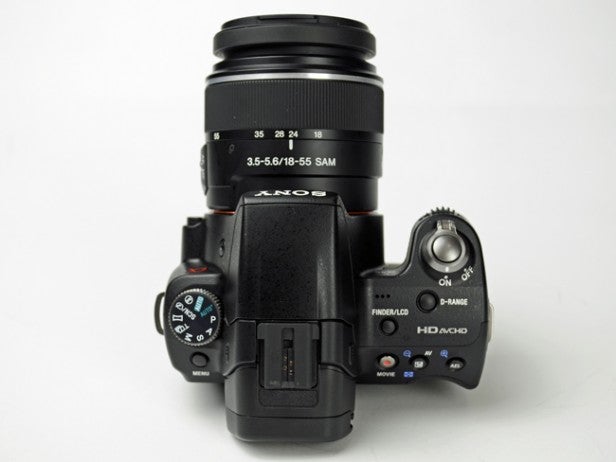
Ideally, we would’ve liked to see the AF points cover a bit more of the screen as they’re bunched quite tightly together in the centre. We were also surprised to note the complete omission of an AF Assist light on the front of the camera. While it’s not exactly new technology, we do quite like how the Eye-Start feature can be set to automatically engage autofocus when the A35 is lifted to eye-level.
With the drive set to Single-shot we were able to shoot full-resolution JPEG and Raw images at approximately one frame per second, with no upper limit on the number of shots we took. This slowed slightly to about seven frames in 10 seconds with the camera set to record Raw and JPEG simultaneously.
Switching over to Continuous mode without the Tele-Zoom feature enabled we were able to record full-resolution JPEGs at the claimed 5fps for a total of around three seconds, after which the camera slowed to about 2fps. Nudging resolution down to you can expect to keep the 5fps frame rate for about five to six seconds, or approximately 30 frames, after which the camera will begin to slow
Using Raw capture, we were only able to shoot continuously for around one and a half seconds, to a maximum six frames, after which the camera dramatically slowed down, capturing one image every three seconds. Shooting Raw and JPEG simultaneously, the A35 was again able to shoot six images in about an second and a half, after which it slowed to one image every three seconds.
Using the Tele-Zoom, the A35 does indeed hit the claimed 7fps, although you can only shoot at this seed for just under three seconds (or around 19 frames) before the buffer fills and the camera begins to slow. It’s not possible to record in Raw while using the Tele-Zoom.
The Sony A35 can be purchased with a 18-55mm f/3.5-5.6 kit lens, a 55-200mm f/4-5.6 telephoto zoom, or as a value package with both lenses together. On the plus side, the 18-50mm (which we used for the overwhelming majority of our test) is impressively sharp across the whole frame and does an especially good job of keeping purple fringing at bay on high-contrast edges. That said, both it and the 55-200mm do feel a bit plasticky and cheap.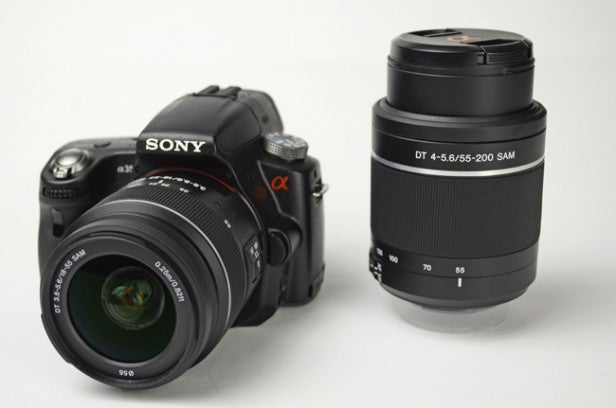
As with all Sony cameras Image Stabilisation technology is built into the camera, so Sony lenses don’t require it. This has the benefit of making them cheaper to buy than their individually stabilised Nikon and Canon counterparts. As Sony continues to gain presence within the DSLR market, so its catalogue of lenses continues to grow. Enthusiasts looking to expand a lens collection will now find plenty of top quality glass in the Sony catalogue.
Turning back to the A35, we have to say that overall image quality is really very good indeed. In fact, never mind its super-fast AF performance and speedy continuous shooting abilities, the A35’s real trump card is actually its image quality. Used on the ‘Standard’ Creative Style, JPEGs are consistently sharp and colourful with good levels of contrast. Detail resolution is excellent as well – just look at the leaves on the trees on the images in our Sample Gallery.
We did notice a slight tendency for the A35 to underexpose on occasion, which can make some images appear a little dark at times, especially in the mid-tones. However, this does have the benefit of retaining more highlight detail in situations where it might otherwise be lost. 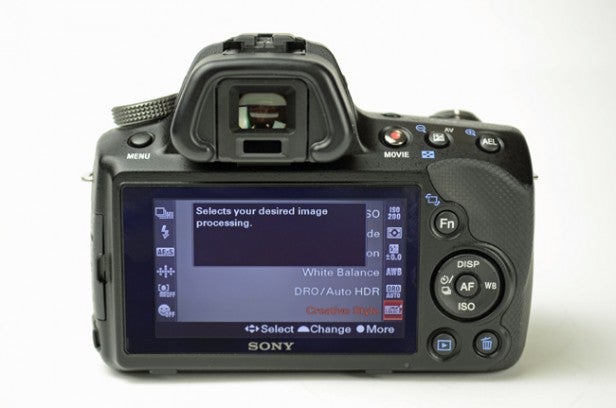
Noise control is similarly very good. From ISO 100 to ISO 400 images are sharp, detailed and free of noise as might be expected, however it’s in the mid- to high settings of ISO 800 to ISO 3200 that the A35 really impresses with noise again kept to a minimum, and without any noticeable softening of detail either. Even the highest available settings of 6400 and 12,800 remain pretty usable when viewed at lesser magnification.
Used on the Automatic White Balance (AWB) setting, the A35 is thoroughly reliable, with images in all lighting conditions, natural and otherwise, coming out neither too warm nor too cold. You can, of course, select one of the regular presets, or even set your own custom colour temperature should you wish to though.
Verdict
While attention is naturally drawn to the super-fast AF and continuous shooting abilities of the A35, what really impresses is overall image quality. Sony has made great strides with its Exmor sensors, and the result here is a camera that performs exceptionally well in low light, producing images with plenty of contrast and punch straight from the camera. The big question is whether you can live with the EVF and its inherent flaws. If you can then the A35 remains worthy of serious consideration.

As this 100% crop reveals, the A35’s base sensitivity of ISO 100 delivers sharp noise-free images

Stepping up to ISO 200 and the A35 is still producing noise-free imags

By ISO 400 the A35 is still delivering excellent results

At ISO 800 there’s a hint of noise, but its really noting to worry about unless you’re pixel peeping

Again, at ISO1600 there’s a hint of noise, but the overall image is still very usable

By ISO 3200 there’s a hint of softening, but the image remains usable

ISO 6400 is the first setting where noise is visible at all image sizes

ISO 12,800 is certainly noisy, yet it isn’t quite the unusable disaster it so often is at this setting

Using the ‘Standard’ Creative Style setting the A35 delivers sharp, punchy images

The A35 delivers good, accurate colour and impressive levels of detail

In Tele-Zoom mode it’s possible to shoot at 7fps, helping you to get the shot you want when faced with a fast-moving subject


Metering is generally very accurate

Although there is a slight tendency for the A35 to underexpose on occasion

The kit lens is impressively sharp

Among the Picture Effects you’ll find a Posterization filter…

And a Retro Photo effect that gives images a worn look

The Pop Colour filter, meanwhile, boosts saturation and contrast

The Panorama mode enables you to make extra-wide images (note that this isn’t the widest example either)

Overall image quality is very good, even when the A35 is used in flat light conditions
Trusted Score
Score in detail
-
Value 7
-
Design & Features 8
-
Image Quality 9
-
Build Quality 7
Features
| Camera type | Digital SLR |
| Megapixels (Megapixel) | 16.2 Megapixel |
| Optical Zoom (Times) | N/Ax |
| Image Sensor | Exmor HD CMOS (23.5 x 15.6mm) |
| Optical focal length | N/A |
| Shutter speed | 30-1/4000sec |
| Auto focus | Yes |
| Manual focus | Yes |
| Max output resolution | 4912 x 3264 |
| Other resolutions | 3568 x 2368, 2448 x 1624 |
| Focus range | N/A |
| Exposure control | PASM, Auto, Auto+, Scene, Panorma, Tele-Zoom |
| Exposure metering | 1200-zone evaluative metering |
| Exposure compensation | ±3 EV (at 1/3 or 1/7 EV steps) |
| Image Stabilisation | Yes, in-camera |
| ISO settings | 100 - 12,800 |
| LCD Monitor | 3in, 921k-dots |
| Viewfinder | Electronic |
| Flash range | GN10 at ISO 100 |
| Flash modes | Flash off, Autoflash, Fill-flash, Slow Sync., Rear Sync, Red-eye reduction, Wireless, Hi-Speed Sync. |
| White balance modes | Six presets + custom |
| Drive modes | Single-shot, Continuous (5fps), Tele-Zoom (7fps) |
| Image formats | JPEG, Raw (.ARW) |
| Picture adjustments | Yes |
| Video (max res/format) | 1920 x 1080 (50i recording, 25 fps image sensor output/ Average bit rate 17 Mbps) |
| Movie length | N/A |
| Self timer | 2sec, 10sec |
| Memory card slot | SD/SDHC |
| Supplied memory | None |
| Batteries supplied | Yes, |
| Charger supplied | Yes |
| A/V output | Yes |
| Charging/Computer Connection | Yes |
| HDMI | Yes |
| AV Out | Yes |
| Manual | Yes |
Physical Specifications
| Dimensions Width (Millimeter) | 124.4mm |
| Depth (Millimeter) | 84.7mm |
| Length (Millimeter) | 92mm |
| Weight (body only) (Kilogram) | 415kg |

